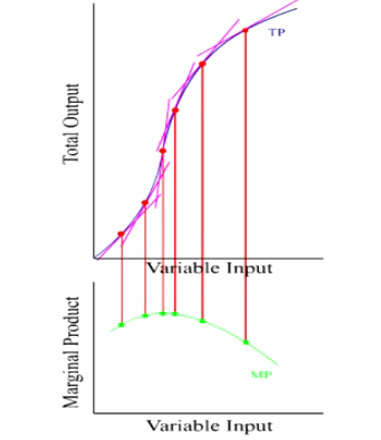Law of Diminishing Returns (transcript)
The Law of Diminishing Returns says that when some inputs are fixed in capacity in the short run, increasing the variable input working with the fixed inputs would first lead to increasing additional output per additional unit of variable input, but eventually decreasing additional output per additional unit of variable input after the optimal capacity of the fixed input has been exceeded.
Let's look at a simple short-run production process where there is a fixed input, a stapler, and some variable input, labor. This process consists of two steps, namely, folding a document twice and stapling it. The stapled document is the output.
When there is just one worker doing the job, she has to switch between folding the documents and stapling them. While she is folding the documents, the stapler lays idle. Since, in the short-run, the number of staplers cannot be increased but the number of workers could be increased, output can be increased by reducing the down time of the stapler. This can be done by adding more workers just folding documents.
How much output can be increased by adding more workers and at what rate?
The production function might look like an S-shaped upward-sloping curve (labeled here as TP, short for total product). An upward sloping curve indicates that output increases with more variable input, namely labor.
The S-shape tells us that the rate of output increase changes along the curve.
First, the lower part rises at an increasing rate as the slope of its tangents gets steeper. The slope of the tangents is known as the marginal product (MP for short). We can plot the MP curve in the lower panel. Rising marginal product means each additional worker adds more to the total output than the one before. This increasing returns results from dividing labor among the workers, a variable input, and reducing the down time of the stapler, a fixed input.
But this phase of the production function is followed by a phase where output increases at a decreasing rate as the slope of its tangents (namely the marginal product) gets flatter. Falling marginal product means that each additional worker adds less to total output than the one before. This decreasing returns results from congestion as the stapler cannot catch up with the folded documents.
Thus an S-shaped TP produces an inverted U-shaped MP with increasing returns followed by decreasing returns.

This phenomenon of decreasing marginal product following increasing marginal product when an increasing amount of variable inputs is combined with some fixed inputs in the short run is known as the Law of Diminishing Returns.
It is also known as the Law of Variable Proportions.
The law of diminishing returns explains why the short-term marginal cost curve is U-shaped and why the tragedy of the commons occurs in the absence of clearly defined property rights.
(Text) Law of Diminishing Returns
This law says that when some inputs are fixed in capacity in the short run, increasing the variable input working with the fixed inputs would first lead to increasing additional output per additional unit of variable input, but eventually decreasing additional output per additional unit of variable input after the optimal capacity of the fixed input has been exceeded.
Topics:
Keywords
increasing returns, law of diminishing returns, marginal product, MP, production function, variable proportions
